
The application of 5G and other mobile communication technologies to education and teaching, and the construction of College English Translation mobile learning and resource sharing model and related models have important scientific value and significance for the effective organization and management of learning resources and the improvement of the speed and efficiency of college english translation resource retrieval. This research mainly combines the characteristics of complementarity and expansion of mobile learning technology for traditional online learning technology. Based on Moodle online teaching platform, this research develops a mobile learning and resource sharing mode for college english translation based on 5G mobile communication technology, designs and implements a mobile learning model based on Moodle platform, and designs the system architecture, functional modules, learning mode and learning process, Finally, the main functional modules of the system model are implemented and tested. To promote mobile learning in the teaching field to play a helping role in a wide range. The experimental results show that the AKAZE algorithm is used to optimize the model, and the overall accuracy rate reaches 74.7%, and the test probability value P (siq)=0.00, which is significantly less than the significant level of 0.05. Therefore, we believe that the application of mobile learning instructional design mode will help students improve their academic performance.
The wide application of mobile terminals in teaching can realize students’ personalized learning, enrich classroom content, improve students’ learning performance, and add fresh vitality to the teaching classroom [1]. Therefore, how to build a reasonable and effective learning resource management platform is the core content to achieve efficient mobile teaching [2]. However, in practical application, there are many problems in the college english translation learning resource management platform system, such as resource redundancy, low precision of resource retrieval, outdated resources, simple storage form of resource inventory, etc. [3]. In addition, due to the influence of traditional concepts and application technologies, the system platform also has problems in the effective use and sharing of resources. These have become the main factors that affect college english learners’ inability to effectively use the system platform, and the main problems faced by the continuing progress of education informatization [4].
In addition, with the intensification of international competition, the concept of lifelong learning in college english translation has been accepted by countries all over the world and has begun to form a systematic system. Lifelong learning refers to the learning from childhood to old age and refers to the learning that students receive at school and the learning of in-service staff training [5,6]. Mobile learning is an important supporting technology to support lifelong learning, school learning and in-service training. The idea of mobile learning and lifelong learning is in harmony, which can help learners improve their culture and skills; It can encourage individual independent learning and team collaborative learning; It can remove the learners’ resistance to the formal learning model; Let learners have a long-term focus on learning; Stimulate learners’ self-esteem; Stimulate learners’ confidence [7]. Therefore, with the enhancement of seamless use of mobile devices and humanized application, human lifelong learning is full of hope [8].
Although there has been a lot of research on the sharing, description, retrieval, and management of college english translation learning resources in the past, the actual application effect is not very ideal. In addition, the rapid development of information networks makes the information and data in the Internet show a surge. From the analysis of the data provided by the company, we can see that the amount of information on the Internet is growing at the speed of, among which structured data only accounts for about [9,10]. At the same time, with the popularization of the Internet and mobile terminals, people can use network devices to connect to the Internet anytime and anywhere, which will lead to the continuous increase of information data [11].
However, as mobile learning is just emerging, to maximize the promotion of mobile learning, we must consider building the foundation for mobile learning, that is, mobile learning and resource sharing model system. However, the development of mobile learning and resource sharing model system involves a lot of programming knowledge. Because of the heavy teaching task, teachers are hard to have time to learn relevant programming knowledge [12,13]. As a result, they cannot develop learning systems suitable for this course according to the actual teaching situation. In addition, most of the existing learning systems of the school are developed by commercial companies, with copyright and high price, and cannot modify the system, This is not suitable for the management of open and independent learning at all, and students are increasingly unfit for the use of the system [14]. It frees english teachers from the complex functional operation of the learning platform and designs mobile learning courses according to their own teaching ideas and experience, so that mobile learning can be promoted.
To sum up, the construction of mobile learning and resource sharing model and related model system for College English Translation based on 5G mobile communication technology has strong practical significance.
The college english translation teaching process is complex, and each link is crucial, so any factor in the teaching design process cannot be ignored. From the overall perspective, the teaching design model consists of four basic elements: teaching objects, teaching objectives, teaching strategies and teaching evaluation. Its simplified model is shown in Figure 1:
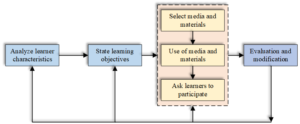
In fact, the learning mode of mobile learning is “personal, seamless, spontaneous, anytime, anywhere”. It focuses on interaction with external college english translation learning environment. It is applied to traditional education, online learning, enterprise training and other aspects. To better play a role in mobile learning, improve teaching efficiency and quality, and ultimately achieve good learning results, good teaching design is essential, as shown in Figure 2.
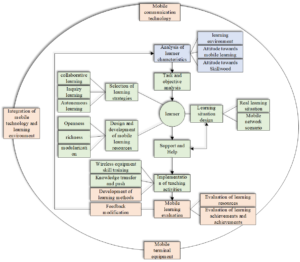
In the process of mobile english teaching, the process of resource sharing design and development is generally from front to back: preliminary analysis, resource design, resource development, resource implementation and resource evaluation, as shown in Figure 3.
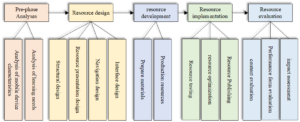
After analyzing the characteristics of basic mobile learning and resource sharing, this manuscript proposes a formal description based on mobile learning system, as shown in Eq. (1):
\[\label{e1} {\text{Mlearn }} = f\{ t,s,LE,c,IT,MM,m\} ,\tag{1}\] where, \(t\) is time, the traditional learning time is discontinuous, while the learning time of mobile learning is continuous. \(S\) is space. Traditional learning space is generally fixed, while mobile learning space is unrestricted, which can be in space or virtual space. \(C\) is content, mobile learning can completely construct structured learning courses for its own learning in a suitable way. \(LE\) is Technology, the technology in mobile learning is very complex, including the network technology of all the technical devices that can solve mobile learning. \(MM\) is mental, the psychological factors of mobile learning learners include interests, learning motivation, learning ability and many other aspects.\(M\) is method. The learning method of mobile learning includes all parameters of learning content in transmission, such as technology, education, etc. In this Eq. (1), mobile learning content includes time, space, learning environment, learning technology, psychological factors of learners and learning methods related to learners.
From this, we can get the representation factors of mobile learning under 5G communication technology, as shown in Eq. [e2]:
\[\label{e2} {\text{c}} = {\text{f}}\{ {\text{MM}},{\text{soc}},{\text{edu}}\} .\tag{2}\]
Tthe psychological factors of learners in mobile learning environment include learners’ interests, hobbies, learning motivation and their knowledge background. \(Soc\) is Socially Responsible, social responsibility in mobile learning. Edu=Educationally Relevant, the field related to education in mobile learning. In this formula, the learning content in mobile learning is mainly determined by learners’ psychological factors, social responsibility, and education level.
In the process of model fitting, to further characterize the model flow of mobile learning and resource sharing, we use the anisotropy of image brightness diffusion to build the scale space, which needs to be solved by partial differential equations. The nonlinear diffusion equation can usually be expressed as Eq. (3):
\[\label{e3} \partial {\text{L}}/\partial {\text{t}} = \operatorname{div} ({\text{c}}({\text{x}},{\text{y}},{\text{t}}) \cdot \nabla {\text{L}}),\tag{3}\] where \(L\) is the image brightness matrix, time \(t\) is the scale parameter, div represents the image divergence, \({\text{c}}({\text{x}},{\text{y}},{\text{t}})\) represents the conduction function, and \(\nabla\)represents the gradient calculation. The conduction function structure can be expressed as Eq. (4):
\[\label{e4} {\text{c}}({\text{x}},{\text{y}},{\text{t}}) = {\text{g}}\left( {\left| {\nabla {L_\sigma }(x,y,t)} \right|} \right).\tag{4}\]
Then, we use Gaussian smoothing to process the gradient value of the post image \({L_\sigma }\) . The form of function g can be expressed as Eq. (5) – Eq. [e7]:
\[\label{e5} {{\text{g}}_1} = \exp \left( { – \frac{{{{\left| {\nabla {L_\sigma }} \right|}^2}}}{{{\lambda ^2}}}} \right).\tag{5}\]
\[\label{e6} {{\text{g}}_2} = \frac{1}{{1 + \frac{{{{\left| {\nabla {L_\sigma }} \right|}^2}}}{{{\lambda ^2}}}}}.\tag{6}\]
\[\label{e7} g 3=\left\{\begin{array}{c} 1 ,\qquad\qquad\qquad\qquad\qquad\left|\nabla L_\sigma\right|^2=0,\\ 1-\exp \left(-\frac{3.315}{\left(\frac{\left|\nabla L_\sigma\right|}{\lambda}\right)^8}\right),\qquad\left|\nabla L_\sigma\right|^2>0. \end{array}\right.\tag{7}\]
Among them, \(\lambda\) is a contrast factor used to control the diffusion degree, which can determine the integrity of edge information retained in the sampling process. The larger \(\lambda\) is the less edge information retained in the mobile learning model.
The basic idea of additive operator splitting diffusion is to decompose a complex multidimensional problem into several simple one-dimensional problems, and then solve them separately to take the average value. Compared with the traditional explicit solution, this method can adopt a larger step size for iteration, with faster convergence and higher stability. First, the original equation is discretized into an implicit difference scheme, as shown in Eq. (8):
\[\label{e8} \frac{{{L^{i + 1}} – {L^i}}}{\tau } = \sum\limits_{l = 1}^m {{A_l}} \left( {{L^i}} \right){L^{i + 1}},\tag{8}\] where \(\tau\) is the iteration step size, and \({A_l}\) is the matrix of the diffusion degree of the feature image on the scale l. The solution of this equation can be expressed as Eq. (9):
\[\label{e9} {L^{i + 1}} = {\left( {I – \tau \sum\limits_{}^{} {_{l = 1}^m{A_l}} \left( {{L^i}} \right)} \right)^{ – 1}}{L_i}.\tag{9}\]
This manuscript takes Eq. (9) as the basic mathematical model to build a mobile learning and resource sharing model for college english translation based on 5G mobile communication technology.
MySQL database provides encryption connection with other multiple databases, and can also perform data batch processing. In this study, five data tables of mobile learning and resource sharing models are created, and the Chinese description of each field is given:
The first part is the user registration information table. As shown in Table 1. This form is used to store student registration information, including student name, login password, student ID and mobile phone number. The student’s name and login password are used for daily login verification. To protect student privacy, mobile phone number can be left blank.
| Serial No | Field Name | Data type | length | Primary key | Is it empty | Field Description |
|---|---|---|---|---|---|---|
| 1 | name | varchar | 10 | Yes | Nonempty | Student Name |
| 2 | password | varchar | 20 | No | Nonempty | Login password |
| 3 | number | varchar | 20 | No | Nonempty | Student ID |
| 4 | phone | varchar | 13 | No | Can be empty | phone number |
The second part is the login information table, as shown in Table 2. This table is used to record students’ mobile learning application login. When students log in to the student client each time, they will automatically send the login time and student name to the database server.
| Serial No | Field Name | Data type | length | Primary key | Is it empty | Field Description |
|---|---|---|---|---|---|---|
| 1 | login Time | varchar | 20 | no | Nonempty | login time |
| 2 | Login Name | varchar | 10 | Yes | Nonempty | Student Name |
The third part is the mobile learning progress record table, as shown in Table 3. This table is used to record the learning progress of students at the mobile learning site, including student name, learning time, learning location, and learning duration. After the data information is stored, it is convenient for the teaching assistant to monitor the learning progress of each student in real time and supervise the learning externally.
| Serial No | Field Name | Data type | length | Primary key | Is it empty | Field Description |
|---|---|---|---|---|---|---|
| 1 | name | varchar | 10 | Yes | Nonempty | Student Name |
| 2 | time | varchar | 20 | No | Nonempty | Time of learning |
| 3 | title | varchar | 100 | No | Nonempty | Learning location |
| 4 | Study Time | int | 10 | No | Nonempty | Learning duration |
The fourth part is the question information table, as shown in Table 4. This table is used to record the information of students’ questions, including their names, time and content.
| Serial No | Field Name | Data type | length | Primary key | Is it empty | Field Description |
|---|---|---|---|---|---|---|
| 1 | name | varchar | 10 | Yes | Nonempty | Ask students’ names |
| 2 | time | varchar | 20 | No | Nonempty | Question time |
| 3 | content | varchar | 200 | No | Nonempty | Questions |
The fifth part is the question reply information table, as shown in Table 5. This table is used to record the information that the assistant teacher replies to the student’s questions in the mobile learning situation. The assistant teacher makes targeted replies to the student’s questions and stores them in the database server. The student client queries the database server’s question reply to information table after each login. If the assistant teacher replies to the student’s questions, download the reply to information.
| Serial No | Field Name | Data type | length | Primary key | Is it empty | Field Description |
|---|---|---|---|---|---|---|
| 1 | name | varchar | 10 | Yes | Nonempty | Ask students’ names |
| 2 | Post time | varchar | 20 | No | Nonempty | Question time |
| 3 | time | varchar | 20 | No | Nonempty | Reply time |
| 4 | content | varchar | 800 | No | Nonempty | Reply content |
In terms of data sources, this study selected students of mathematics class 1301 in a university as the research object, through a period of observation and in combination with the students’ computer scores at the end of last semester, the students in this class are divided into: Group A with strong computer acceptance ability and excellent computer performance and Group B with moderate computer acceptance ability. However, to ensure the representativeness of the experimental results, the experimental group and the control group selected 16 students from A and B respectively, and they have not yet learned EXCEL2010 Chart Creation and Editing, to judge the simulation and growth of the mobile learning model.
SQLite, the underlying optimization algorithm of the model, is used in the application layer, application framework layer, system runtime, and Linux kernel layer of the mobile device operating system, as shown in Figure 4. SQLite is integrated in the system runtime and runs on the Linux kernel layer.
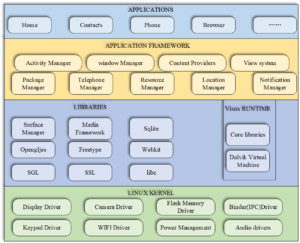
Since the data on the mobile learning mobile client needs not only to be uploaded to the database server but also stored in the local database, the tables existing on the database server also exist in the local database. The author will not repeat the structure of each table here. However, MySQL databases can create data tables through the Navi cat for MySQL visual interface without writing code. SQLite needs to use code to penetrate data tables.
Based on this, we can set the model system structure to have five basic levels, as shown in Figure 5.

It can be seen from the figure that the IEEE-LTSC learning technology system has a five layer structure from the essence of learning to the realization of computer technology: 1. learners interact with the environment. This layer is the goal of learning technology system design. 2. Design feature layer related to learners. This layer mainly emphasizes learners’ feedback on the learning effect of using the system. 3. LTSA system component layer. This layer mainly describes the general significance of learners’ discovery of learning on component-based architecture. 4. The view level of teachers and learners in the learning technology system. This layer is mainly used as a reference for later maintenance when the system is running. 5. API encoding protocol layer. This layer is mainly realized by computer technology. In these five layers, the first layer should consider both the realization of learning technology system computer technology and the teaching process. In other words, this layer is also a bridge, which builds education and technology. In the development of this architecture, the system component layer is the focus.
Learners who choose mobile learning should complete the specified tasks within a specified class time (tasks must be submitted within the specified time), change the file name of the completed tasks to “student number name”, and then submit the tasks to the server. The author logs in to the server to download the task files submitted by all learners. After collecting the final learning task results of all learners, the author scores all the learners in turn according to the scoring rules and enters the learner’s scores into the score sheet in turn, and finally collects the student scores of the experimental group and the control group. After the students in the experimental group finish their study, they should evaluate the recognition of the teaching design model constructed through the self-made questionnaire of this study. We compared the scores of the control group and the experimental group as samples and conducted independent sample T test through SPSS software. The test results are shown in Table 6.
| Group | Number | Average | standard deviation | Mean value of standard error | |
|---|---|---|---|---|---|
| Fraction | 1 | 32 | 91.07 | 4.691 | 0.829 |
| – | 2 | 32 | 84.29 | 9.093 | 1.608 |
Through the control group experiment, it can be found that the test probability value P (siq)=0.00, which is significantly lower than the significant level of 0.05. Based on the above, we believe that the performance of the control group using the mobile learning instructional design model has a significant impact. In addition, the average score of the experimental group is 91.06 points, and the average score of the control group is 84.28 points. The score of the experimental group is significantly higher than that of the control group.
After students submit their homework, they use the mobile learning platform to send the teaching design model identification questionnaire. Collect, sort out and analyze the results fed back by the experimental subjects, as shown in Figure 6: 68.75% of the experimental subjects are very interested in using WeChat to carry out “computer based” mobile learning activities; 56.26% of the subjects believed that mobile learning had brought convenience to learning; 72% of the subjects believed that instructional design made learning easier, more convenient and more effective; 85% of the subjects believed that the instructional design model strengthened the communication with other learners; 56.25% of the subjects believed that instructional design strengthened the final learning effect.
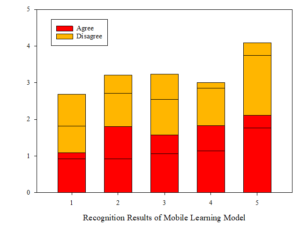
To better compare and analyze the performance difference between AKAZE optimization algorithm and other feature detection algorithms in the construction of mobile learning models, three algorithms are used to match the image features of models in the mobile learning and resource sharing experimental group and the control group. Mularczyk mobile learning database sets variables for factors affecting learning image features, such as image blur, compression, illumination intensity, angle of view, rotation, and scaling. Five groups of images are selected, and each group of images takes 6 variable values for a certain influencing factor, keeping consistent with other factor variables. The first group, Boat learning group, is composed of six images with different rotation and scaling degrees; The second group, Leuven learning group, was composed of six images with different brightness; The third group, Ubc learning group, had six images with different compression levels; The fourth group, Bikes learning group, was composed of six images with different degrees of blur; The fifth group, Graf learning group, is composed of six images with different perspectives. The first image of each group of images is a preset image, and the other five images are matching images. The matching situation and preset situation are matched with three algorithms respectively, and the matching time and accuracy are compared. The learning situation matching process uses ratio ratio scheme for calculation and screening. Since ORB algorithm, BRISK algorithm descriptor and AKAZE algorithm M-LDB descriptor are all stored in binary form, hamming distance is used for rough matching during feature point matching, and possible feature point pairs are selected and filtered and eliminated by RANSAC algorithm, as shown in Figure 7, Figure 8, Figure 9 and Figure 10.
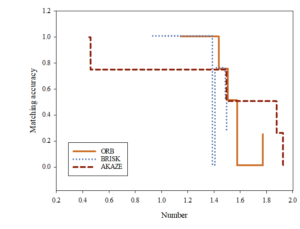
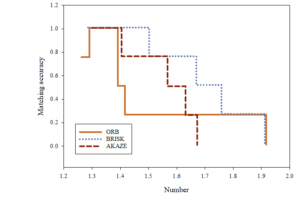
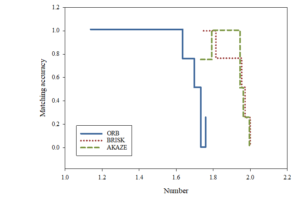

Figure 7 shows the matching accuracy of the three algorithms under different rotation scaling angles. The average matching accuracy of ORB algorithm is 61.2043%, that of BRISK algorithm is 66.5227%, and that of AKAZE algorithm is 74.6991%. ORB algorithm can deal with small rotation and scaling of images well, but it cannot deal with large rotation and scaling of images. BRISK algorithm is stable, and AKAZE algorithm is the most stable.
Figure 8 shows the performance analysis and comparison data of ORB, BRISK and AKAZE algorithms from the two dimensions of matching accuracy and matching time. The ordinate represents the matching accuracy, in percentage form, and the abscissa represents the matching image number in each group of images.
Figure 9 shows the matching accuracy of the three algorithms under different learning durations. The learning durations of matched images decrease in turn. The average matching accuracy of ORB algorithm is 73.1271%, that of BRISK algorithm is 76.6142%, and that of AKAZE algorithm is 81.8454%. The three algorithms are similar to each other in that the image is affected by the change of learning time, but the matching accuracy of AKAZE algorithm is higher than that of the other two algorithms.
Figure 10 shows the matching accuracy of the three algorithms under different fuzzy degrees. The average matching accuracy of AKAZE algorithm is 76.6311%. Both ORB algorithm and BRISK algorithm cannot deal with the situation of blurred images very well. Especially in the matching process of the mobile learning experiment group, the correct rate of using ORB algorithm to match is only 29.2035%, while AKAZE algorithm has better relative performance.
Mobile learning based on communication and 5G network is an inevitable trend in the future. Based on the development of 5G and other communication technologies, this manuscript constructs a model of mobile learning and resource sharing in college english translation and conducts an empirical test and algorithm efficiency analysis on this model. The experimental results show that the AKAZE algorithm is used to optimize the model, and the overall accuracy rate reaches 74.7%, and the test probability value P (siq)=0.00, which is significantly less than the significant level of 0.05. Therefore, we believe that the application of mobile learning and resource sharing instructional design model will help students improve their learning achievements.
There is no funding support for this study.